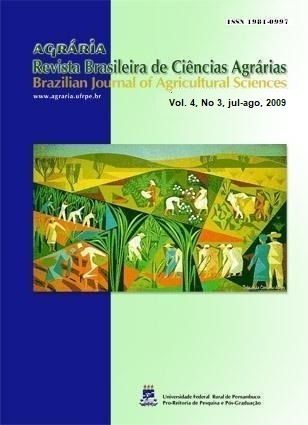Carrot water requirement determination using drainage lysimeters, in the Pernambuco State “Agreste”
DOI:
https://doi.org/10.5039/agraria.v4i3a13Keywords:
crop coefficient, evapotranspiration, Class A PanAbstract
Water requirement evaluation and crop coefficient estimates is very important for an adequate irrigation management. However, there is a lack of information about the northeast edafoclimatic semiarid conditions, particularly for the carrot crop. The objective of this work was to evaluate the carrot
evapotranspiration and crop coefficient (Kc) in fishing (Pesqueira) region, in an alluvial area of semiarid of Pernambuco State, Brazil, where communal irrigated agriculture is developed. Three drainage lysimeters were used, being the crop evapotranspiration (ETc) assessed by mass balance during a 5-day period and the reference evapotranspiration (ETo) was estimated by Class A Pan methodology. The cumulative ETo during the experimental period was 615 mm, while the ETc was 812 mm. The coefficients range obtained, considering Kp values of 0.81 and 0.75 to the different growth stages, were: 1.08-1.16; 1.41-1.52; 143-1.55 and 1.40-1.52, respectively, at the initial (20 days after plantation - DAP), development (50 DAP), middle (80 DAP) and final (98 DAP) phases, being the average Kc of 1.35 and 1.46 for the whole period. These values are higher than the ones presented by FAO and highlight the necessity of investigation of crop coefficient under local conditions.



